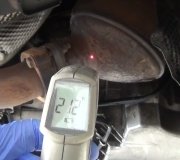That "spray" test is meaningless. Before you go any further, get a fuel pressure gauge, connect it at the fuel rail, then run the hose under the back of the hood and hook the gauge under a wiper arm so you can read it while driving. My suspicion is you're going to see fuel pressure gradually drop off. If you don't have a fuel pressure gauge, you can usually borrow one from an auto parts store that rents or borrows tools. Here's a link that shows how to do this, if you need it:
https://www.2carpros.com/articles/how-to-check-fuel-system-pressure-and-regulator
What you described matches exactly what happened to me twice in 440,000 miles on my '88 Grand Caravan, right down to the 15 minutes. Without going into the long and exciting story of spending four hours trying to get through Minneapolis, the engine ran fine at highway speed and when accelerating. It would stall when the largest volume of fuel needed to be pumped, which is during coasting. I can explain that later.
Chrysler fuel filters commonly last the life of the vehicle. Other than with diesel engines, you'll never solve a running problem on one of them by replacing the fuel filter. However, the elusive cause of this problem was the pickup screen, or "sock" inside the gas tank. Microscopic debris migrates over to it while you're driving, and in roughly 15 minutes it blocks that screen or causes it to collapse by the pump pulling against that restriction. After sitting on the side of the road in a pile of tears for a few minutes, the sock stretches out and opens up again, then you can drive for another mile or two. This has also happened to me twice on cars with carburetors. On those you simply can't get enough fuel volume, so the engine might idle, but you can't accelerate. Since then, we've had about a dozen people have the same issue on other brands of cars.
Now that I know the cause, there's two things you can try to verify if this is the correct diagnosis. The first is if your fuel pressure regulator has a vacuum hose connected to it, disconnect that hose and plug it. That will cause fuel pressure to go very high, but fuel volume will go way down. You'll get black smoke out of the tail pipe, but no more stalling.
The second time this happened to me, I was pulling a tandem axle enclosed trailer that is bigger and heavier than the van. I had been chasing this problem for quite a while, so I had the fuel pressure gauge already strapped to the radio antenna. While tugging the trailer down the road, I saw the fuel pressure slowly go from a normal 45 psi down to 20 psi over about 20 seconds. Unlike most other brands, the engine still ran fine at 20 psi. It started to sputter when it got down to 15 psi. Then, if I lifted the accelerator pedal for just an instant, then pushed it again, the pressure would instantly pop back up to 50 psi, then resume its gradual drop. By lifting the pedal repeatedly, I nursed it home over 50 miles without any indication others would see as a problem. Both times a new sock solved the problem. If you check on a site like for Rock Auto or even some local parts stores, you will find a replacement sock when they can be replaced separately. Mine cost $12.00 and just snapped onto the bottom of the fuel pump housing. There are some models that require you to replace the entire housing to get the new sock.
Let me know what you find with these suggestions.
Friday, August 16th, 2024 AT 6:38 PM


